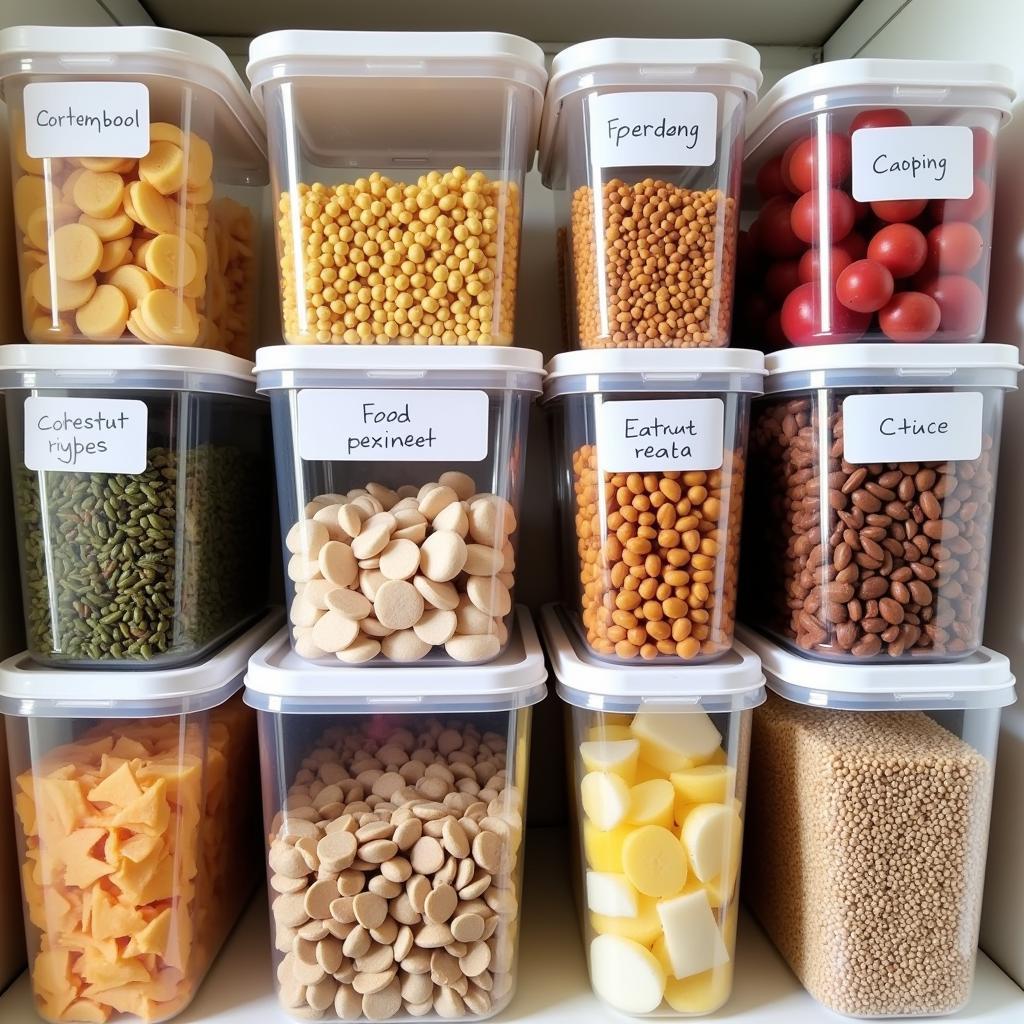Preparing for unexpected events is crucial, and having a well-stocked emergency food supply is a fundamental aspect of being ready. Food Storage For Emergency situations goes beyond just gathering cans of beans; it requires careful planning and consideration to ensure you have nutritious and palatable options available when you need them most.
Choosing the Right Food for Emergency Storage
When selecting food for your emergency stash, prioritize shelf-stable items that require minimal to no preparation. Think canned goods, dried fruits and nuts, granola bars, peanut butter, and ready-to-eat meals. A two-week emergency food supply should include a variety of foods to ensure nutritional balance and avoid monotony.
Here are some key factors to consider:
- Shelf Life: Opt for foods with a long shelf life, ideally those that can last for several years. Freeze-dried meals, canned goods, and dehydrated foods are excellent choices. Check expiration dates regularly and rotate your stock using the FIFO (First In, First Out) method.
- Nutritional Value: While tempting, loading up solely on sugary snacks or instant noodles isn’t sustainable. Prioritize nutrient-rich options like canned fish, vegetables, and fruits, beans, lentils, and whole grains like brown rice or quinoa.
- Water Needs: Keep in mind that some foods require water for cooking. Ensure you have an adequate water supply for both drinking and preparing food. Consider including items that require minimal water or no-cook options.
- Dietary Restrictions: Factor in any dietary needs or allergies within your household. If you follow a specific diet like veganism, explore options such as vegan freeze-dried food.
Organizing Your Emergency Food Supply
 Organized Food Storage Containers
Organized Food Storage Containers
A well-organized food storage system is essential for easy access and efficient stock rotation. Consider these tips:
- Choose Suitable Containers: Invest in airtight containers, preferably transparent ones, to protect your food from pests, moisture, and light. A 2-gallon food container can be a good option for storing bulk grains or legumes.
- Label Everything Clearly: Label each container with the food type, the date of storage, and the estimated shelf life.
- Store in a Cool, Dark, and Dry Place: Avoid storing your emergency food supply in areas with extreme temperatures or humidity fluctuations. A cool, dark pantry or basement is ideal.
- Rotate Your Stock Regularly: Regularly check expiration dates and use the FIFO method to ensure you consume the oldest items first, replenishing your supply accordingly.
Beyond the Basics: Enhancing Your Emergency Food Storage
- Cooking Equipment: While focusing on no-cook or ready-to-eat meals is wise, having alternative cooking methods is beneficial. A camping stove, fuel, and basic cooking utensils can significantly expand your meal options.
- Comfort Foods: Emergencies are stressful; including familiar comfort foods can provide a much-needed morale boost.
- Special Considerations: If you have infants or young children, ensure you have an adequate supply of formula, baby food, and other essentials.
“During emergencies, access to fresh food can be limited,” says Sarah Thompson, a certified nutritionist and emergency preparedness expert. “Having a well-planned emergency food supply ensures you and your family have access to essential nutrients, reducing stress and promoting well-being during uncertain times.”
Maintaining Your Emergency Food Supply:
- Periodic Checks: Inspect your food storage every few months for any signs of damage, pests, or spoilage.
- Practice Meals: Occasionally, incorporate items from your emergency food supply into your regular meals. This familiarizes you with the taste and preparation while allowing you to rotate your stock effectively.
Food Storage for Emergency: Peace of Mind Through Preparation
By diligently planning your emergency food storage, you’re taking a proactive step towards ensuring your family’s well-being during unexpected events. Remember, it’s not just about having enough food, but ensuring it’s safe, nutritious, and provides some sense of normalcy in challenging situations.
For those with specific dietary needs, it’s worth exploring options like Wise Company food shelf life for extended shelf-life solutions tailored to various dietary preferences.
Taking the time to prepare today can provide invaluable peace of mind for tomorrow.
FAQs about Food Storage for Emergency
- How much food should I store for an emergency? Aim for at least a two-week supply of food per person.
- What are the best containers for storing food long-term? Airtight, moisture-proof containers, like Mylar bags or food-grade buckets, are ideal.
- How often should I rotate my emergency food supply? It’s best to rotate your stock every 6 to 12 months, depending on the product’s shelf life.
- Can I store water for emergencies? Yes, store at least one gallon of water per person per day for drinking and sanitation.
- Where should I keep my emergency food supply? A cool, dark, and dry place, like a basement, pantry, or closet, is best.
Need more information about food safety and storage?
- Explore our article on aircraft food carts for insights into how the aviation industry prioritizes food safety and storage efficiency.
Don’t hesitate to contact us! Call us at 02437655121 or email us at minacones@gmail.com. Our dedicated customer support team is available 24/7. You can also visit us at our address: 3PGH+8R9, ĐT70A, thôn Trung, Bắc Từ Liêm, Hà Nội, Việt Nam. We are here to assist you!